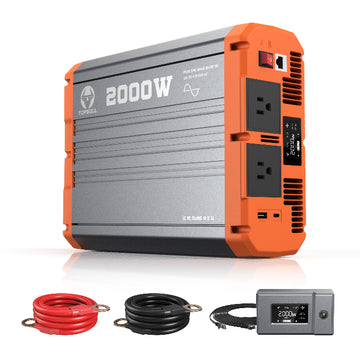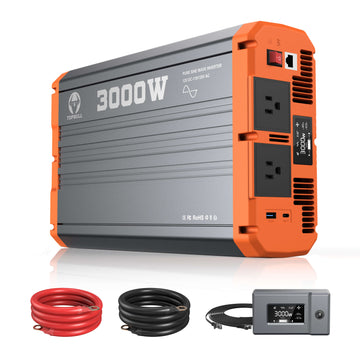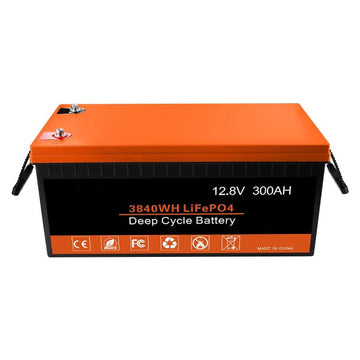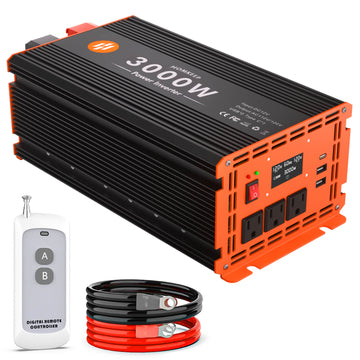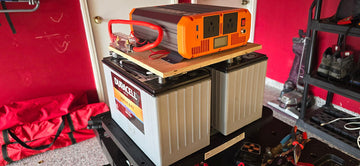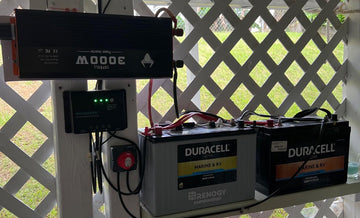Whether you're traveling in an RV, camping, or living in an off-grid cabin, you can't power your appliances with a battery system without an inverter. You typically have two choices: a sine wave inverter and a square wave inverter. Both types of inverters may look similar on the outside, but the changes that occur on the inside can determine the performance, longevity, and safety of your equipment. In this article, we'll analyze the differences and help you make your choice.
What is a sine wave inverter?
Sine wave inverters produce a smooth, consistent waveform that matches the grid's AC power output. They are better at controlling power surges and have a very low potential to damage equipment. The stable, high-quality waveforms make sine wave inverters ideal for devices that require constant current, such as electronic equipment and motors.
Sine wave inverters undergo complex processing to produce a smooth, continuous and regular sine curve (as shown in the figure). This technology provides “flawless” power support for sensitive electronic equipment. Accordingly, sine wave inverters are more expensive.

What is a square wave inverter?
A square wave inverter output generates a “discontinuous” waveform directly by switching the direction of the voltage rapidly (e.g., using a MOSFET or transistor). The voltage of the waveform jumps instantaneously between positive and negative, without the smooth transitions of a sine wave. The jagged voltage jumps (0V instantly rising to peak voltage) result in poor power quality and can pose a potential risk to sensitive equipment.
But square wave inverters are simple and inexpensive, making them still a good choice for appliances that don't require precise current flow.

Sine wave vs. square wave inverters: some key differences
Understanding the differences between sine wave inverters and square wave inverters will help you make the best choice for your specific application needs.
Waveform quality
The main difference between these two types of inverters is the waveform. Sine wave inverters produce the same smooth, continuous waveform as the grid, and this “clean power” can avoid the impact of sudden voltage changes on the capacitive and inductive components of the equipment, and prolong the life of the equipment. Square wave inverters, on the other hand, produce a stepped waveform, where the voltage jumps instantaneously between zero and peak, resulting in THD>40%, which can easily lead to equipment heating and motor vibration.
Equipment Compatibility
Sine wave inverters support all types of loads, including resistive, capacitive and inductive loads. Square wave inverters are only suitable for purely resistive loads, i.e. equipment where electrical energy is directly converted into heat.
Energy Efficiency and Battery Consumption
Sine wave inverter adopts high frequency PWM modulation technology, the energy conversion efficiency reaches 90%-95%, which reduces battery consumption. Square wave inverters are only 70-80% efficient due to harmonic energy waste. Under the same load, the battery drains faster, and long-term use may shorten the life of lead-acid batteries (20% fewer cycles). For example, at 1000W load, the battery life is 1-2 hours less than a sine wave inverter.
Noise
Sine wave inverters are suitable for quiet environments, they do not generate additional resonance or electrical noise. You will also work more efficiently in a zero noise environment. On the contrary, a square wave inverter's sudden voltage changes can cause vibrations, whistling and even a “buzzing” electromagnetic interference sound. You may have to put it in a separate room.
Cost
When purchasing an inverter, price is the number one factor that people consider. Sine wave inverters are slightly more expensive than square wave inverters due to their more complex internal design. However, this “high investment” often leads to long-term value. Sine wave inverters are compatible and equipment friendly, extending the life of appliances and reducing the cost of repair or replacement due to electrical problems.
Square wave inverters, by contrast, are simple and inexpensive, but may have higher maintenance costs over the long term. It is suitable for temporary use or projects with restricted budgets.
| Feature | Sine Wave Inverter | Square Wave Inverter |
| Waveform | Smooth and stable | Stepped, unstable |
| Cost | High | Low |
| Efficiency | High | Low |
| Applications | Suitable for all equipment | Not friendly to inductive devices |
| Noise | Normal or zero noise | Noisy |
When to choose sine wave or square wave inverter?
You already know the difference between the two inverters, here is a detailed decision guide for the different user groups:
Scenarios for choosing a sine wave inverter
1. You plan to use sensitive equipment
If you plan to power sophisticated equipment such as laptops, desktops, sound systems, printers, medical equipment. Then a sine wave inverter is your only safe option. These devices require strict power waveforms. The smooth waveform of a sine wave inverter prevents sudden voltage changes from damaging sensitive circuits and ensures stable operation. While square wave current may cause flickering screen, noise, overheating or directly burn the motherboard.
2. You have motor-type equipment at home
If you intend to power motorized equipment, such as refrigerators, air conditioners, washing machines, power tools, water pumps, etc... These devices rely on a smooth current to start and run, and only a sine wave can ensure that they don't heat up, whine, trip, or interfere with the grid. Voltage jumps in square wave inverters can cause motor windings to overheat and efficiency to drop by more than 30%.
3. High frequency use
If you want to use the inverter power supply in your RV or home in remote areas, pure sine wave inverter is the first choice in order to ensure the stability of power supply and usage experience. Especially when there are multiple appliances such as laptops, air-conditioners, refrigerators or coffee makers working at the same time, choosing a sine wave inverter can significantly improve system reliability and reduce energy loss.
4. Noise-sensitive environments
In scenarios such as bedrooms, offices or hospital wards, it is best to use a sine wave inverter for quiet operation. Sine wave inverters have no high-frequency beeps and do not interfere with Wi-Fi or Bluetooth signals.
Scenarios for choosing a square wave inverter
1. Temporary use without compromising equipment life
If you're just camping to temporarily power a few lights or heaters and don't require much in the way of system efficiency, compatibility and equipment life, square wave inverters are inexpensive short-term solution. However, you need to be careful not to use it continuously for too long to avoid overheating the device.
2. You have a very limited budget
Square wave inverters are suitable for one-off projects, teaching purposes or low power demand scenarios due to their simple design and low price. Examples include small DIY solar systems or low-power emergency backup power.
3. You only power resistive loads
You if you want to drive non-precision power tools for short periods, such as incandescent lamps, simple heaters, electric stoves, electric blankets, and so on. These devices do not contain motors or control chips and do not depend on waveform smoothness; the square wave output can be easily driven. However, the temperature of the device needs to be closely monitored and sine wave is still recommended for long term use.
Most recommended sine wave inverter
Topbull sells only high-performance inverters that have been tested and approved by users. To help you quickly find the right product for your needs, we recommend several pure sine wave inverters that excel in performance, stability and user reviews.

-
2000W Pure Sine Wave Inverter
This 2000W pure sine wave inverter is ideal for RVs, van conversions and small off-grid applications. It is capable of stably driving devices such as refrigerators, TVs, laptops, fans, small microwave ovens and more. -
3000W Pure Sine Wave Inverter
If you want to run multiple large appliances at the same time, such as air conditioners, washing machines, induction cookers, etc., then this 3000W inverter will be a cost-effective choice for you. It offers greater continuous power capacity and supports high power starting loads while maintaining stable voltage and ultra-low noise output. -
4000W Pure Sine Wave Inverter
This 4000W sine wave inverter is a reliable “mains power” for large loads or when you need to drive multiple high power consuming devices at the same time (e.g. air conditioner + water heater + microwave oven).
FAQ
Q: Which is better square wave or sine wave?
A: Sine wave inverters are better for most equipment because they provide smooth, steady power, just like utility power. Square wave inverters are less expensive, but are only suitable for simple loads such as heaters or lights.
Q: What are square waves used for?
A: Square waves are primarily used to power simple devices such as heaters and incandescent lamps. Square wave is also commonly used for timing and testing of low-cost inverters, signal processing and digital electronics.
Q: What are the advantages of square waves?
A: Square waves are inexpensive and easy to produce, making them ideal for low-cost inverter designs. They work well with simple resistive loads such as heaters and lights.

